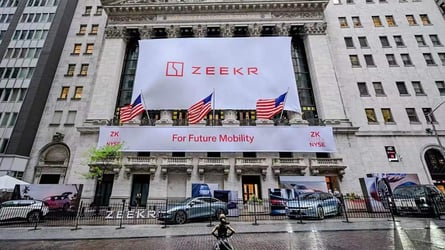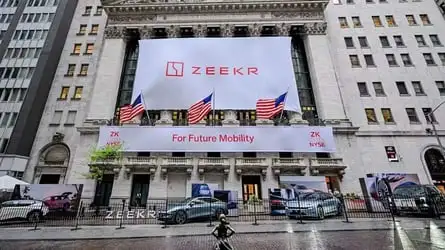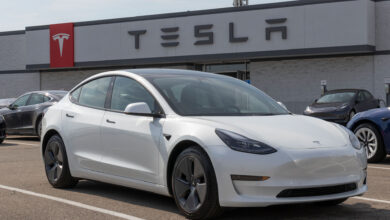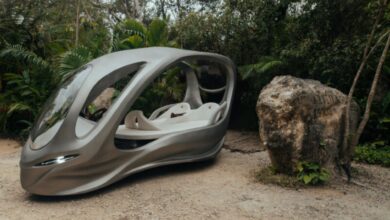The Automotive Cold War Is Officially Underway

The White House plans to slap 100% tariffs on Chinese-made electric vehicles, according to The Wall Street Journal.


May 10, 2024 at 1:50pm ET
Two things of note in the electric vehicle world happened today around the same time. First, the Geely Group-owned Chinese EV brand Zeekr debuted on the New York Stock Exchange today at a valuation of around $5.2 billion. Then, around 250 miles south in Washington, D.C., news emerged that the Biden Administration is set to quadruple tariffs on Chinese-made electric cars if they hit American roads.
The timing may be purely coincidental. But after this week, one thing feels clearer than ever: the automotive Cold War between China and the West is fully underway, and EVs specifically are at the center of it all.
China’s EV threat
China has emerged as the leading manufacturer of electric cars and the batteries that power them. That poses a threat to the U.S. auto industry.
The Wall Street Journal got the scoop that the White House plans to announce higher tariffs on Chinese clean-energy imports in the coming days. Under the reported new policies, tariffs on Chinese EVs are set to quadruple, rising from the current 25% to a whopping 100%, anonymous sources told the outlet. In theory, that would substantially increase the cost of any Chinese-made EVs on our market, including, potentially, ones sold by known Western and other Asian brands.
It’s no secret why the U.S. is attempting to push back on Chinese EVs, to say nothing of other clean energy imports from that country like solar panels.
China has spent years aggressively building up its capacity to manufacture electric cars. It’s developed a stranglehold on the supply chains for lithium-ion batteries and the critical minerals they contain. It has lavished state incentives on both EV production and purchasing. In recent years, the country has emerged as a global EV powerhouse—and, for the first time ever, an exporter on par with leaders like Japan and Germany.
Many still believe that China’s cars are cheap and technologically subpar. But the truth is China has learned to build cars very, very well, as InsideEVs‘ own Kevin Williams discovered during a recent trip to the Beijing auto show. China’s homegrown electrified vehicles range from the inexpensive—some, like the BYD Seagull, cost less than $10,000 in their home market—to higher-end, luxury-focused offerings like the Yangwang U8, a kind of plug-in hybrid competitor to the Mercedes G-Class that can “float” on water. From batteries to software, most are incredibly advanced.
Car companies and policymakers in the U.S. (and Europe) say these cars pose a real threat to our nascent EV market, where many options still remain unaffordable and things like batteries and software are works in progress. In response, European Union officials have also launched investigations into Chinese imports that could lead to stronger tariffs.
Chinese companies like BYD, the country’s largest EV manufacturer, already sell vehicles worldwide across Asia, South America and Europe. The U.S., the world’s second-largest vehicle market after China, is widely seen as Chinese EV makers’ next target. BYD and others would likely set up manufacturing in Mexico, and some are already eyeing this.
There are already some Chinese-made EVs available in the U.S. from European or American brands. Lincoln and Buick both import models to the U.S. that are China-made. Polestar, an electric-only offshoot of Volvo, sells the Polestar 2 sedan. Volvo’s upcoming EX30 crossover will be made in China. (Both Volvo and Polestar are owned by Geely, the Chinese auto group that debuted Zeekr on Wall Street today.)
Volvo has touted the EX30’s $35,000 starting price as a potential game-changer in the U.S. market. But that price includes the current 25% tariff; would the car get more expensive now, before it goes on sale here? Would the new policy impact Volvo’s reported plans to recover tariffs through exports from its U.S. plant? A Volvo spokesperson declined to comment on the company’s pricing strategy to InsideEVs, which is to say that for now, nobody knows. It’s still unclear exactly which cars the new tariffs will apply to.
According to The Wall Street Journal, the new tariffs on Chinese goods will also hit solar panels, batteries and critical battery minerals. We’ll have to wait and see what the details bear out.
It’s also no coincidence this is happening during an election year. Electric cars have emerged as a new battleground in the intensifying right-left culture wars. The looming threat of cheap, appealing vehicles built by a clear adversary has raised alarm across the political spectrum.
Former President Donald Trump established the existing 25% tariff on Chinese cars. As he seeks reelection, he has said on the campaign trail that he would raise that to 100%. He’s said, controversially, that if he were to lose, it would amount to a “bloodbath” for the American auto industry.
But the drum-beating hasn’t just come from the Republican Party. Biden’s Treasury Secretary Janet Yellen recently warned China that the U.S. wouldn’t just absorb its excess production of EVs.
“When the global market is flooded by artificially cheap Chinese products, the viability of American and other foreign firms is put into question,” Yellen told Chinese officials during a trip to Beijing earlier this year.
The Biden Administration is also working to prop up domestic EV and battery manufacturing. The $7,500 tax credit for EV purchases, for example, only applies to vehicles made in the U.S. without Chinese components. And scores of Inflation Reduction Act incentives are boosting local battery and EV plants in the U.S. and North America, although it will be years before all are running at full steam. In effect, the tariffs may end up buying the U.S. some time, rather than being a permanent solution here.
After all, as Kevin Williams pointed out after going to Beijing: all of these crackdowns aren’t guaranteed to yield better cars from Ford, General Motors and the rest.
And so, the automotive Cold War has ramped up. And like the last Cold War, it’s just one more proxy battle between the superpowers of the East and West—except this time, the geopolitical adversary is also one of the world’s largest economies and a top trading partner. Nothing about this is going to be easy to untangle.
Got a tip? Contact the author: tim.levin@insideevs.com
Additional reporting by Patrick George.
Read more



